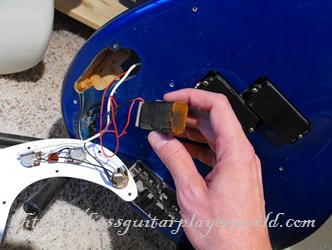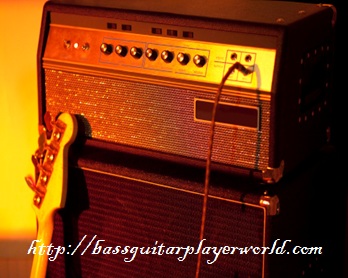Bass Guitar Setup And Repair

Scroll down to see all the articles…
After a few months of owning your guitar, you may have noticed that there are a few things wrong with it. Namely, it plays differently. The strings are higher and require more pressure to fret, it doesn’t resonate as well as it used to; minor issues here and there.
Well, believe it or not, bass guitars require setups.
Sound crazy?
It shouldn’t. Instruments are like cars, and the bass guitar is absolutely no exception; after a while, they require a bit of fine tuning to keep performing their best.
In this section, we will teach you how to set up your bass guitar so that it plays as good as new or, in some cases, even better than new.
Let’s Get the Engine Rollin’
The first thing you will need to do before you both doing anything else is remove your old strings. Once they are off, toss them out and grab some guitar cleaner, some lemon oil, a microfiber cloth, a tooth brush, and some cotton swabs.
Now set to work cleaning your bass guitar!
This is not only the first step in setting up your bass, but it is also the most important. Proper maintenance will keep your bass in proper playing condition and avoid any rust, mold, or any other possible issues that could in turn rot out your bridge and neck and render a setup useless.
Scrub behind those frets with the toothbrush, and then get to work cleaning your bridge out with those cotton swabs. When finished, pour some lemon oil on your fret board and allow it soak in for ten minutes. Then, wipe away the excess and pop on a new set of strings. Don’t use the old strings; they’re old.
Getting the Intonation of the Guitar Correct
 Once you have your bass guitar tuned up with the new set of strings, it’s time for some intonation. To intonate your bass, plug your bass into a tuner. The best kind to use is a chromatic, as it reads more efficiently for intonations.
Once you have your bass guitar tuned up with the new set of strings, it’s time for some intonation. To intonate your bass, plug your bass into a tuner. The best kind to use is a chromatic, as it reads more efficiently for intonations.
First, pluck your open E and make sure it is tuned perfectly. Then, fret the twelfth fret of your E. The note should be an E, and it should be perfectly in tune. If it isn’t, it’s time for some adjustments.
Get a screw driver or Allen wrench (whichever your string’s saddle requires). If your twelfth fret E was flat, tighten a tiny bit. If it was sharp, loosen a tiny bit. Tightening brings the saddle closer to the nut, while loosening brings it further from the nut.
For each tiny adjustment, retune your open E. Don’t get lazy and skimp either; every adjustment either adds or reduces tension, which in turn changes the tuning of the strings. Once you have perfect tuning on both your open E and your twelfth fret E, repeat on your other strings.
Re-check for Any Signs of Damage
The final piece to a proper setup is checking your bass guitar neck to make sure it isn’t bowed. Do this beholding your bass forty-five degrees from you. If you notice a dip, you will need to loosen the truss rod. If you notice an arch, you will need to tighten the truss rod.
The truss rod should be located just behind the nut, behind the strings. Based on your neck’s issue, either tighten or loosen the truss rod a quarter of a turn at a time until the neck is level. Once it is, your bass guitar is properly set up, and you are ready to go!
For more tips and advice on various bass setup and repair issues, be sure to check out the links below…
Articles on Bass Guitar Setup And Repairs:
#1 – Steps On How to Setup Your Bass Guitar Properly
If you had just bought your instrument, here’s something you need to perform prior to playing it. With a properly set up guitar, you will find it easier to play with and get more enjoyment out of your bass guitar.
#2 – What You Can Do About Fret Buzzing Problems And Eliminate Them
Fret buzzing is usually caused by the frets rubbing against the string when a note is played. Not only does this heavily dampen the note, it also causes an unwanted buzz. Typically, this can be corrected by changing the action of your guitar or remedying a twisted neck.
#3 – Insights to Get the Perfect Instrument And Buying a Bass Guitar
So you’ve saved up money and you are now ready to make a purchase for your dream instrument. Before that, it would do you good to read this article to get insights on buying the best bass that your money can get you.
#4 – Adjusting the Saddle For Intonation Corrections
The bass guitar saddle is the part of the instrument where the strings lay on at the far end. Adjusting the saddle is an action that is taken to correct intonation problems. Find out how you can perform this action correctly here.
#5 – Warped Bass Guitar Neck – What Can You Do?
One of the biggest nightmares that a bassist can get is to see a warped neck on your bass guitar. While it seems serious and is often overstated, a twisted neck is a pretty common issue and you can actually remedy the problem yourself.
#6 – Adjusting the Truss Rod Within the Fretboard – Issues to Be Aware Of
As a bass player, it is your duty to maintain and make sure that your instrument is kept in tip-top conditions. By learning how to adjust the truss rod in your bass guitar, you can keep the neck in a healthy shape and avoid irreversible damage.
#7 – Adjusting Pickup Height For The Perfect Tonal Balance
Besides affecting the output of your bass’s signal, adjusting the pickup height of your bass guitar can also affect the instrument’s intonation. We show you the tips and tricks to get this done properly.
Check Out The Perfect Learning Tool For Bassists of All Skill Levels
JamPlay offers the best online bass instructions on the Internet. With hundreds of professionally recorded lessons, Jamplay is the ideal place to learn the basics and improve your bass playing skills. With great teachers and carefully planned lesson structures, I guarantee you will be able to take your bass playing to a higher level in no time.






One Comment
I have a bass and now an amplifier. The lead was old but not damaged as far as I could see. Plugged into amp turned on however, no sounds. Amp is new, VOX. changed lead still no sound. When I first got it the earth was dodgy so I took it to a friend of a friend of mine. (he is a musician and recommended this chap). Any ideas on what could be wrong? I am just getting started as a player and I don’t want this little obstacle to put me off trying to learn bass. Many thanks Si.